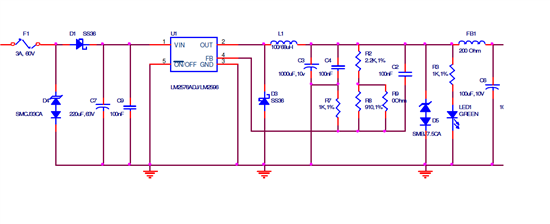Hi,
I am observing a strange problem on my design with LM2576 simple switcher. My input voltage from the Power supply latches to a value of 5V at times. I have searched on the internet and found about the voltage latch up problem. However, most resources that I could find mention that the latch-up is a startup phenomenon. I have observed that in my system, the voltage changes at run time also and can take values from say 5v to 12 volts during operation. I am using a 12V power supply from a Car battery, so I do not suspect that the current delivery capability is an issue.
This has become an issue, since there is a significant failure of the boards that suffer from this problem. I have also observed a couple of burnt up LM2576, please help me understand what I am doing wrong with my power supply design.
Please see the schematic for the power supply attached.


